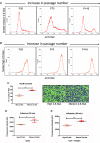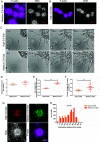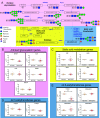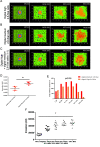Heterogeneity in 2,6-Linked Sialic Acids Potentiates Invasion of Breast Cancer Epithelia
- PMID: 33532574
- PMCID: PMC7844859
- DOI: 10.1021/acscentsci.0c00601
Heterogeneity in 2,6-Linked Sialic Acids Potentiates Invasion of Breast Cancer Epithelia
Abstract
Heterogeneity in phenotypes of malignantly transformed cells and aberrant glycan expression on their surface are two prominent hallmarks of cancers that have hitherto not been linked to each other. In this paper, we identify differential levels of a specific glycan linkage: α2,6-linked sialic acids within breast cancer cells in vivo and in culture. Upon sorting out two populations with moderate, and relatively higher, cell surface α2,6-linked sialic acid levels from the triple-negative breast cancer cell line MDA-MB-231, both populations (denoted as medium and high 2,6-Sial cells, respectively) stably retained their levels in early passages. Upon continuous culturing, medium 2,6-Sial cells recapitulated the heterogeneity of the unsorted line whereas high 2,6-Sial cells showed no such tendency. Compared with high 2,6-Sial cells, the medium 2,6-Sial counterparts showed greater adhesion to reconstituted extracellular matrices (ECMs) and invaded faster as single cells. The level of α2,6-linked sialic acids in the two sublines was found to be consistent with the expression of a specific glycosyl transferase, ST6GAL1. Stably knocking down ST6GAL1 in the high 2,6-Sial cells enhanced their invasiveness. When cultured together, medium 2,6-Sial cells differentially migrated to the edge of growing tumoroid-like cocultures, whereas high 2,6-Sial cells formed the central bulk. Multiscale simulations in a Cellular Potts model-based computational environment calibrated to our experimental findings suggest that differential levels of cell-ECM adhesion, likely regulated by α2,6-linked sialic acids, facilitate niches of highly invasive cells to efficiently migrate centrifugally as the invasive front of a malignant breast tumor.
© 2021 The Authors. Published by American Chemical Society.
Conflict of interest statement
The authors declare no competing financial interest.
Figures






Similar articles
-
Differential expression of the α2,3-sialic acid residues in breast cancer is associated with metastatic potential.Oncol Rep. 2011 May;25(5):1365-71. doi: 10.3892/or.2011.1192. Epub 2011 Feb 22. Oncol Rep. 2011. PMID: 21344161
-
An Interplay Between Reaction-Diffusion and Cell-Matrix Adhesion Regulates Multiscale Invasion in Early Breast Carcinomatosis.Front Physiol. 2019 Aug 13;10:790. doi: 10.3389/fphys.2019.00790. eCollection 2019. Front Physiol. 2019. PMID: 31456688 Free PMC article.
-
Increased alpha2,6-sialylation of surface proteins on tolerogenic, immature dendritic cells and regulatory T cells.Exp Hematol. 2006 Sep;34(9):1212-8. doi: 10.1016/j.exphem.2006.04.016. Exp Hematol. 2006. PMID: 16939814
-
ST6GAL1: A key player in cancer.Oncol Lett. 2019 Aug;18(2):983-989. doi: 10.3892/ol.2019.10458. Epub 2019 Jun 7. Oncol Lett. 2019. PMID: 31423157 Free PMC article. Review.
-
IgG and leukocytes: Targets of immunomodulatory α2,6 sialic acids.Cell Immunol. 2018 Nov;333:58-64. doi: 10.1016/j.cellimm.2018.03.014. Epub 2018 Mar 31. Cell Immunol. 2018. PMID: 29685495 Free PMC article. Review.
Cited by
-
Glycoproteogenomics characterizes the CD44 splicing code associated with bladder cancer invasion.Theranostics. 2022 Mar 28;12(7):3150-3177. doi: 10.7150/thno.67409. eCollection 2022. Theranostics. 2022. PMID: 35547758 Free PMC article.
-
Comparative evaluation of methods for isolating extracellular vesicles from ICC cell culture supernatants: Insights into proteomic and glycomic analysis.Cell Commun Signal. 2025 Apr 29;23(1):207. doi: 10.1186/s12964-025-02207-x. Cell Commun Signal. 2025. PMID: 40301937 Free PMC article.
-
Apoptotic signaling by TNFR1 is inhibited by the α2-6 sialylation, but not α2-3 sialylation, of the TNFR1 N-glycans.J Biol Chem. 2025 Jan;301(1):108043. doi: 10.1016/j.jbc.2024.108043. Epub 2024 Nov 29. J Biol Chem. 2025. PMID: 39615678 Free PMC article.
-
α2,6 sialylation distinguishes a novel active state in CD4+ and CD8+ cells during acute Toxoplasma gondii infection.Front Immunol. 2024 Aug 26;15:1429302. doi: 10.3389/fimmu.2024.1429302. eCollection 2024. Front Immunol. 2024. PMID: 39253089 Free PMC article.
-
Exploring New Frontiers: Alternative Breast Cancer Treatments Through Glycocalyx Research.Breast J. 2025 May 22;2025:9952727. doi: 10.1155/tbj/9952727. eCollection 2025. Breast J. 2025. PMID: 40443562 Free PMC article. Review.
References
Grants and funding
LinkOut - more resources
Full Text Sources
Other Literature Sources
Miscellaneous

